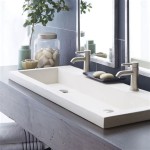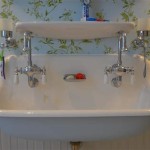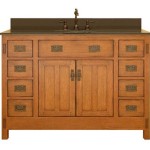Industrial Bathroom Sinks: The Strength and Hygiene of Stainless Steel
Industrial bathrooms, found in factories, workshops, commercial kitchens, and public facilities, require fixtures that can withstand heavy use, resist corrosion, and maintain a high level of hygiene. Stainless steel industrial bathroom sinks emerge as a durable, practical, and aesthetically pleasing solution. The material properties of stainless steel make it exceptionally well-suited for environments where cleanliness is paramount and durability is non-negotiable. Understanding the material composition, benefits, design considerations, and maintenance requirements of stainless steel industrial bathroom sinks allows facility managers and builders to make informed decisions regarding outfitting high-traffic, demanding washroom spaces.
The Advantages of Stainless Steel
Stainless steel is an alloy comprised primarily of iron, chromium, and often nickel, along with smaller amounts of other elements. The chromium content, typically above 10.5%, is critical for forming a passive layer of chromium oxide on the surface of the material. This passive layer provides the material with inherent corrosion resistance, preventing rust formation even when exposed to moisture, chemicals, and harsh cleaning agents. This characteristic is crucial in industrial settings where sinks are frequently exposed to various substances.
Beyond corrosion resistance, stainless steel offers exceptional strength and durability. It can endure impacts, abrasions, and thermal fluctuations without significant damage. This resilience translates to a longer lifespan for the sink, reducing the frequency and cost of replacements. The non-porous nature of stainless steel further contributes to its hygienic properties. Unlike porous materials, stainless steel does not harbor bacteria, mold, or other microorganisms, making it easier to clean and sanitize. This feature is especially important in environments where hygiene is a top priority, such as food processing plants and healthcare facilities.
Furthermore, stainless steel is a sustainable choice. It is 100% recyclable, and the recycling process does not degrade its quality. This makes it a responsible and environmentally friendly option for industrial bathroom fixtures. The inherent longevity of stainless steel products also contributes to sustainability by reducing the need for frequent replacements and minimizing waste generation.
Design Considerations for Industrial Bathroom Sinks
The design of a stainless steel industrial bathroom sink will depend heavily on the specific application and the anticipated usage patterns. Several key considerations must be factored in to ensure optimal functionality, durability, and accessibility. These include the sink's size, shape, mounting style, and features like faucet placement and drain configuration.
Sink size directly correlates with the volume of use. High-traffic areas often benefit from larger, multi-station sinks that can accommodate multiple users simultaneously. This reduces congestion and promotes efficient handwashing. Sink depth is another important factor. Deeper sinks are better suited for tasks that involve splashing or require submersion of items, while shallower sinks may be adequate for simple handwashing. The shape of the sink can also impact its functionality. Rounded corners are easier to clean than sharp corners, minimizing the buildup of dirt and bacteria. Sloped surfaces promote efficient water drainage, preventing standing water and reducing the risk of bacterial growth.
Mounting style is another critical design consideration. Wall-mounted sinks conserve floor space and facilitate easy cleaning underneath. This is particularly advantageous in environments where hygiene is paramount. Countertop sinks offer a more integrated look and can provide additional workspace around the sink. Freestanding sinks are a versatile option that can be placed anywhere with adequate plumbing connections. The choice of mounting style should be based on the available space, the desired aesthetic, and the specific needs of the application.
Faucet placement and drain configuration are also important design considerations. Faucets should be positioned to provide adequate water flow without causing excessive splashing. Sensor-operated faucets can further enhance hygiene by eliminating the need for physical contact. The drain should be located in a position that allows for efficient water drainage. Strainers and basket drains can prevent debris from clogging the drainpipes. Overflow drains are also important to prevent water damage in case of accidental overflows.
Types and Gauges of Stainless Steel
Not all stainless steel is created equal. Different grades and gauges of stainless steel offer varying levels of corrosion resistance, strength, and durability. Selecting the appropriate grade and gauge is crucial for ensuring the long-term performance of the sink in an industrial environment. The two most common grades of stainless steel used in sink manufacturing are 304 and 316.
Type 304 stainless steel, also known as 18/8 stainless steel, contains 18% chromium and 8% nickel. It offers excellent corrosion resistance to a wide range of chemicals and environments. It is a versatile and cost-effective option for many industrial applications. Type 316 stainless steel, also known as marine grade stainless steel, contains 16% chromium, 10% nickel, and 2% molybdenum. The addition of molybdenum enhances its corrosion resistance, particularly in environments with high chloride concentrations, such as coastal areas or facilities that use salt-based cleaning agents. Type 316 stainless steel is generally preferred in environments where corrosion is a significant concern.
The gauge of stainless steel refers to its thickness. Lower gauge numbers indicate thicker steel. Thicker stainless steel is more durable and resistant to dents and scratches. In industrial settings, where sinks are subjected to heavy use and potential impacts, a thicker gauge is generally recommended. For most industrial applications, a gauge of 16 or 18 is suitable. Lighter gauges, such as 20 or 22, may be acceptable for light-duty applications, but they are more susceptible to damage and may not provide adequate durability in demanding environments.
Installation and Maintenance
Proper installation is crucial for ensuring the longevity and performance of a stainless steel industrial bathroom sink. Incorrect installation can lead to leaks, instability, and premature failure. Installation should be performed by qualified plumbers or contractors who are familiar with the specific requirements of stainless steel fixtures. The mounting surface should be level and sturdy enough to support the weight of the sink and its contents. Proper sealing is essential to prevent water damage around the edges of the sink. The drain connections should be properly tightened to prevent leaks.
Routine maintenance is also essential for keeping a stainless steel sink in optimal condition. Regular cleaning with mild soap and water is typically sufficient to remove dirt and grime. Abrasive cleaners should be avoided, as they can scratch the surface of the stainless steel. Periodic polishing with a stainless steel cleaner can help to maintain its shine and prevent staining. Hard water stains can be removed with vinegar or a specialized hard water stain remover. It's important to always rinse the sink thoroughly after cleaning to remove any residue.
For specific stains or stubborn buildup, specialized stainless steel cleaning products may be required. However, it is crucial to follow the manufacturer's instructions carefully and test the product in an inconspicuous area before applying it to the entire surface. Harsh chemicals, such as bleach or hydrochloric acid, should be avoided, as they can damage the stainless steel. Promptly addressing any leaks or drainage issues can prevent further damage and extend the lifespan of the sink.
Cost Considerations
The initial cost of stainless steel industrial bathroom sinks can be higher compared to sinks made from other materials, such as porcelain or plastic. However, the long-term benefits of stainless steel often outweigh the initial investment. The durability and longevity of stainless steel translate to reduced replacement costs over time. The low maintenance requirements also contribute to cost savings by minimizing the need for specialized cleaning products and labor. The increased longevity can result in lower total cost of ownership when considering lifespan and maintenance.
When evaluating the cost of stainless steel sinks, it is important to consider the grade and gauge of the material. Higher grades and thicker gauges will generally result in a higher initial cost, but they also offer superior performance and durability. The design and features of the sink can also impact the cost. Multi-station sinks, custom designs, and features like sensor-operated faucets will typically be more expensive than standard models. It is prudent to obtain multiple quotes from different suppliers to ensure that the sink is procured at a competitive price.
The installation costs should also be factored into the overall budget. Complex installations that require extensive plumbing modifications or custom fabrication may be more expensive. It is advisable to obtain quotes for both the sink and the installation separately to ensure full cost transparency.
Meeting Codes and Standards
Industrial bathroom sinks must comply with various building codes and standards to ensure the safety and accessibility of the facilities. These codes and standards often specify requirements for sink height, water temperature, faucet operation, and drainage. Compliance with the Americans with Disabilities Act (ADA) is particularly important to ensure that the sinks are accessible to individuals with disabilities. The ADA specifies requirements for sink height, knee clearance, and faucet operation to accommodate individuals using wheelchairs. It is crucial to consult with local building inspectors and code officials to ensure that the sinks meet all applicable requirements.
Several organizations develop standards for plumbing fixtures, including the American Society of Mechanical Engineers (ASME) and the Canadian Standards Association (CSA). These standards specify requirements for the materials, design, and performance of plumbing fixtures. Compliance with these standards ensures that the sinks are safe, reliable, and durable. Certification by a recognized testing laboratory, such as Underwriters Laboratories (UL) or NSF International, can provide assurance that the sinks meet the applicable codes and standards.
Many jurisdictions also have specific regulations regarding water conservation. These regulations may specify requirements for faucet flow rates and water usage. Installing low-flow faucets and water-efficient fixtures can help to reduce water consumption and lower utility costs. Some jurisdictions offer incentives or rebates for installing water-efficient fixtures.

Commercial Bathroom Vanities Sinks Neo Metro By Acorn

Commercial Bathroom Sinks Wall Mount Sink For Hand Washing Sloan

High End Commercial Rectangular Bathroom Stainless Steel Kitchen Sink China Sinks Made In Com

Ridalco Stainless Steel Restaurant Commercial Sinks

Custom Trough Sinks Stainless Steel Pure Copper Havens Luxury Metals

Kitchen Sinks Commercial Sink Stainless Steel Wall Mounted Hand Wash For Laboratory Laundry Bathroom China Foot Operated

H D 14ga Ada Round Bowl Wash Up Sink 66 R0206624b010 Commercial Stainless Steel Sinks

Kitchen Sinks Commercial Sink Stainless Steel Wall Mounted Hand Wash For Laboratory Laundry Bathroom China Foot Operated

Industrial Bathroom Sinks Ping And Inspiration Hunker

Solid Surface Sinks Are Choices For Commercial Restrooms Construction
Related Posts







